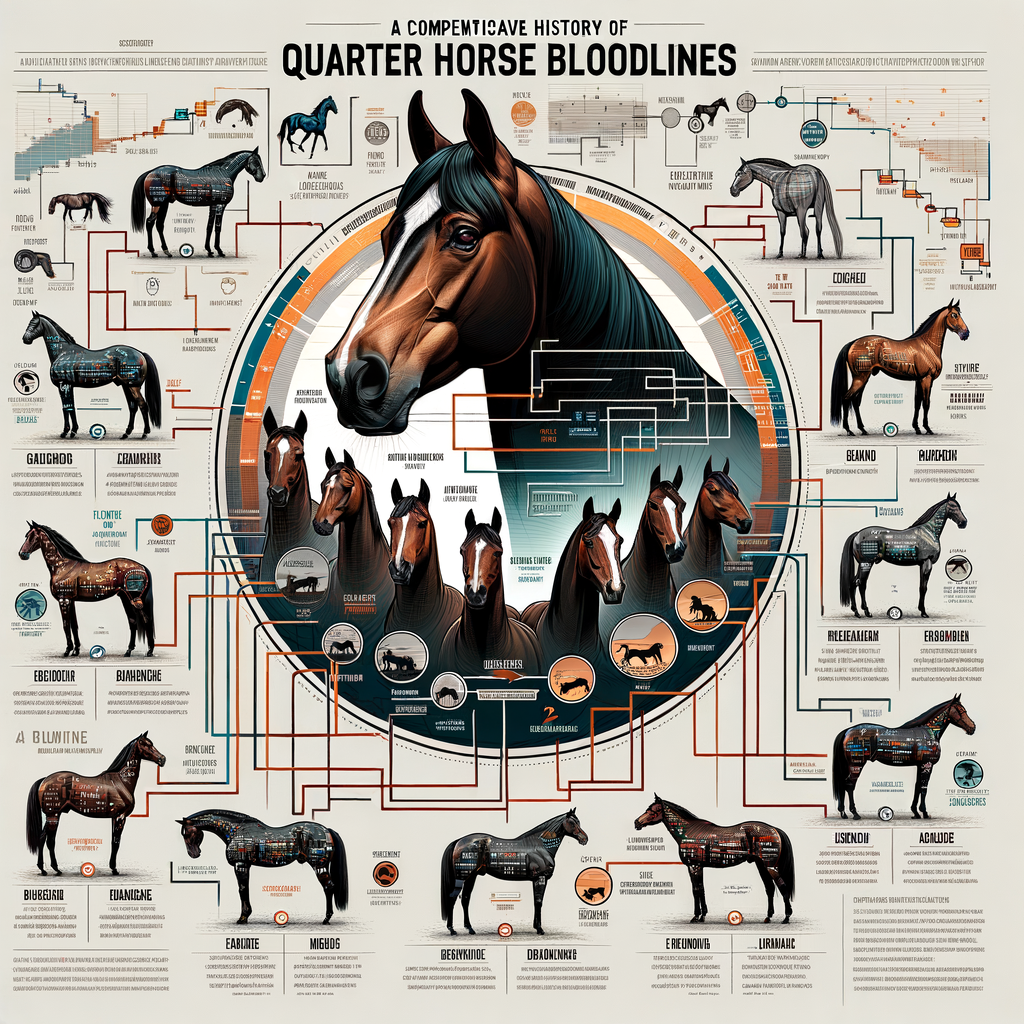
Introduction to Quarter Horse Genetics
Genetics is a fascinating field of study that helps us understand how traits are passed from parents to offspring. This knowledge is particularly important when it comes to breeding Quarter Horses, a popular breed known for its speed, agility, and versatility. Let’s delve into the world of Quarter Horse genetics and explore how it influences the traits and abilities of these magnificent creatures.
- Understanding the basics of Quarter Horse genetics
- How genetics influence Quarter Horse traits and abilities
At the heart of Quarter Horse genetics are genes, which are like tiny instruction manuals that tell the horse’s body how to grow and function. Each horse has two sets of genes, one from each parent. These genes determine everything about the horse, from its color and size to its speed and strength.
Genes are located on structures called chromosomes. Horses have 64 chromosomes, arranged in 32 pairs. Each parent contributes one chromosome to each pair. When a horse is conceived, it receives a random mix of its parents’ genes. This is why offspring can have traits that are different from both of their parents.
Genes play a significant role in determining a Quarter Horse’s traits and abilities. For instance, the gene for speed is dominant in Quarter Horses, which is why they are renowned for their sprinting ability. Other traits, like coat color and pattern, are also determined by genetics.
However, it’s important to note that genetics isn’t the only factor that influences a horse’s traits and abilities. Environment, training, and care can also play a significant role. For example, a horse with the genes for speed won’t reach its full potential if it doesn’t receive proper training and care.
In conclusion, understanding Quarter Horse genetics can provide valuable insights into the breed’s traits and abilities. It can also guide breeding decisions to produce horses with desired characteristics. However, genetics is just one piece of the puzzle. A horse’s environment, training, and care are also crucial in shaping its traits and abilities.
History of Quarter Horse Bloodlines
The history of Quarter Horse bloodlines is a fascinating journey that takes us back several centuries. This breed, known for its speed and agility, has a rich heritage that is deeply intertwined with the history of the United States.
The Origin of Quarter Horse Pedigree
Let’s delve into the origins of the Quarter Horse pedigree and explore the significant events that shaped this breed’s ancestry.
- The early beginnings of the Quarter Horse lineage:
- Key historical events shaping the Quarter Horse ancestry:
The Quarter Horse lineage traces back to the 1600s when English colonists in Virginia crossed imported Thoroughbreds with native horses. The goal was to create a fast, sturdy horse capable of working on the colonial farms. The result was a versatile breed, known for its speed over short distances, hence the name ‘Quarter Horse’.
Several historical events played a pivotal role in shaping the Quarter Horse ancestry. The westward expansion in the 19th century, for instance, increased the demand for sturdy, fast horses. Ranchers and cowboys favored Quarter Horses for their agility and speed, making them an integral part of the American West’s development.
Another significant event was the formation of the American Quarter Horse Association (AQHA) in 1940. The AQHA played a crucial role in preserving the breed’s characteristics and promoting its popularity. Today, the AQHA registers more Quarter Horses than any other breed, underscoring the breed’s enduring appeal.
In conclusion, the Quarter Horse lineage is a testament to the breed’s adaptability and resilience. From its early beginnings in colonial America to its prominence in the American West, the Quarter Horse has remained a symbol of strength and speed. Its rich history continues to captivate horse enthusiasts around the world.
Evolution of Quarter Horse Bloodlines
The Quarter Horse breed has a rich history that has seen many changes over the years. Let’s delve into the major shifts in breeding practices and the impact of modern technology on studying Quarter Horse bloodlines.
- Major shifts in Quarter Horse breeding practices over the years
- Impact of modern technology on studying Quarter Horse bloodlines
In the early days, Quarter Horses were bred for their speed and agility, making them perfect for cattle herding and horse racing. However, as the needs of horse owners evolved, so did the breeding practices. In the 20th century, breeders began to focus more on the horse’s conformation – their physical appearance and structure – and less on their speed. This shift was driven by the growing popularity of horse shows and the desire for a more versatile horse that could excel in a variety of disciplines, not just racing.
Another significant shift came with the introduction of artificial insemination in the 1960s. This technology allowed breeders to mate horses that were physically distant, leading to a greater diversity in the gene pool and the creation of new bloodlines.
Modern technology has revolutionized the way we study Quarter Horse bloodlines. DNA testing, for example, has made it possible to accurately determine a horse’s lineage and identify specific genetic traits. This has been invaluable in breeding programs, allowing breeders to select for desirable traits and avoid genetic diseases.
Additionally, online databases and pedigree analysis software have made it easier than ever to research a horse’s ancestry. Breeders can now access detailed information about a horse’s relatives, their performance records, and their genetic traits, all with a few clicks of a mouse.
In conclusion, the evolution of Quarter Horse bloodlines has been shaped by changes in breeding practices and the advent of modern technology. These factors have allowed the breed to adapt and thrive in a changing world, ensuring its continued popularity and success.
Renowned Quarter Horse Bloodlines
When it comes to Quarter Horses, there are a few bloodlines that stand out due to their significant influence and contributions to the breed. These bloodlines have produced some of the most successful and versatile horses in the history of the breed.
Notable Quarter Horse Families
Let’s delve into some of the most influential Quarter Horse families that have left an indelible mark on the breed.
- Exploring the most influential Quarter Horse families
- Case study: The legacy of a specific famous Quarter Horse family
One of the most influential families in Quarter Horse history is the King Ranch family. Originating from the legendary sire, King P-234, this family has produced numerous champions in various disciplines, from racing to cutting. The King Ranch bloodline is known for its versatility, athleticism, and strong work ethic.
Another notable family is the Three Bars family. Known for their speed and agility, horses from this bloodline have excelled in racing and barrel racing. The Three Bars bloodline has also contributed to the development of other prominent Quarter Horse families, such as the Dash For Cash and Easy Jet families.
Let’s take a closer look at the legacy of the King Ranch family. King P-234, the foundation sire of this family, was born in 1932. Despite his humble beginnings, King P-234 went on to become one of the most influential sires in Quarter Horse history.
King P-234 sired over 20 AQHA Champions, and his descendants have continued his legacy, excelling in various disciplines and contributing to the diversity and versatility of the Quarter Horse breed. Today, the King Ranch family is still highly sought after for their athleticism, versatility, and strong work ethic.
In conclusion, the Quarter Horse breed is rich in history and diversity, thanks to the influential families that have shaped its development. These families have produced horses that excel in various disciplines, showcasing the versatility and adaptability of the breed.
Significant Quarter Horse Sires and Dams
Our journey into the world of Quarter Horse bloodlines would be incomplete without paying homage to the significant sires and dams that have left an indelible mark on this breed’s history. These horses have not only achieved personal success but have also shaped the current Quarter Horse bloodlines through their progeny.
- Highlighting Key Sires and Dams in Quarter Horse History
Let’s take a moment to appreciate some of the most influential sires and dams in Quarter Horse history.
| Sire/Dam | Notable Achievements | Impact on Quarter Horse Bloodlines |
|---|---|---|
| King P-234 | Inducted into the AQHA Hall of Fame in 1997 | King P-234 sired 20 AQHA Champions, influencing the Quarter Horse breed with his speed and versatility. |
| Leo | Recognized for his speed, he sired 211 performing foals | Leo’s offspring have excelled in various disciplines, contributing to the versatility of the Quarter Horse breed. |
| Missy Bar | Produced 9 AQHA Champions | Missy Bar’s offspring have perpetuated her speed and agility in the Quarter Horse breed. |
- How These Horses Have Shaped Current Quarter Horse Bloodlines
The influence of these remarkable sires and dams is evident in the current Quarter Horse bloodlines. Their exceptional traits have been passed down through generations, shaping the breed’s characteristics and performance abilities.
For instance, the speed of King P-234 and Leo, and the agility of Missy Bar, are traits that are highly sought after in today’s Quarter Horses. Their progeny have not only inherited these traits but have also passed them on to subsequent generations, thereby shaping the breed’s evolution.
In conclusion, the significant sires and dams in Quarter Horse history have played a pivotal role in defining the breed’s identity. Their legacy continues to live on in the current Quarter Horse bloodlines, underscoring the importance of genetics in horse breeding.
Studying Quarter Horse Bloodlines
Understanding the bloodlines of Quarter Horses is a fascinating journey into the history and genetics of this popular breed. It can help breeders make informed decisions and enthusiasts gain a deeper appreciation for these magnificent animals.
Methods for Tracing Quarter Horse Ancestry
There are several methods available for those interested in tracing the ancestry of Quarter Horses. These methods can provide valuable insights into the horse’s lineage, performance, and potential health issues.
- Techniques for researching Quarter Horse heritage
- Resources for studying Quarter Horse bloodlines
One of the most common techniques for researching a Quarter Horse’s heritage is through pedigree analysis. This involves studying the horse’s family tree, which can often be traced back several generations. Pedigree analysis can provide information about a horse’s ancestors, their achievements, and any genetic diseases that may be present in the bloodline.
Another technique involves DNA testing. This can provide a more detailed view of a horse’s genetic makeup, including its breed composition and potential health risks. DNA testing can also confirm parentage, which is especially useful in breeding programs.
There are many resources available for those interested in studying Quarter Horse bloodlines. These include breed registries, pedigree databases, and genetic testing services.
The American Quarter Horse Association (AQHA) is a valuable resource. It maintains a comprehensive database of registered Quarter Horses, including their pedigrees and performance records. The AQHA also provides educational materials and resources for understanding Quarter Horse genetics and bloodlines.
Online pedigree databases are another useful tool. These databases allow users to search for a specific horse and view its pedigree, often with information about each ancestor. Some databases also provide performance records and other details.
Genetic testing services can provide a wealth of information about a horse’s genetic makeup. These services can test for specific genes, confirm parentage, and identify potential health risks. They can also provide a detailed analysis of a horse’s breed composition.
By using these methods and resources, anyone can delve into the fascinating world of Quarter Horse bloodlines. Whether you’re a breeder, an enthusiast, or just curious, understanding a Quarter Horse’s ancestry can provide a deeper appreciation for this remarkable breed.
Understanding Quarter Horse Pedigree Charts
When it comes to understanding the genetics and heritage of Quarter Horses, pedigree charts are a valuable tool. These charts provide a comprehensive view of a horse’s lineage, tracing back several generations. Let’s delve into how to read and interpret these charts, and what key insights we can gain from them.
- How to read and interpret a Quarter Horse pedigree chart
- Key takeaways from analyzing a Quarter Horse’s pedigree
A Quarter Horse pedigree chart is like a family tree for horses. It starts with the horse in question at the center and branches out to include parents, grandparents, and so on. Each horse’s name is usually accompanied by information about its achievements and notable characteristics. Here’s a simplified example:
| Generation | Left Side (Sire’s Lineage) | Right Side (Dam’s Lineage) |
|---|---|---|
| Parents | Thunderbolt (Champion Racer) | Starlight (Award-winning Jumper) |
| Grandparents | Lightning, Raindrop | Moonbeam, Sunray |
Reading from left to right, you can trace the lineage through the sire’s (father’s) side and the dam’s (mother’s) side. The more you know about each horse in the lineage, the better you can understand the potential genetic traits of the horse in question.
By analyzing a Quarter Horse’s pedigree, you can gain insights into its potential abilities and characteristics. For instance, if a horse comes from a long line of champion racers, it may have a genetic predisposition for speed. Similarly, a lineage of award-winning jumpers may indicate a natural aptitude for jumping. However, remember that while genetics play a significant role, training and care are equally important in shaping a horse’s abilities.
In conclusion, understanding a Quarter Horse’s pedigree chart can provide valuable insights into its lineage and potential abilities. It’s a fascinating part of studying Quarter Horse bloodlines and an essential tool for breeders, trainers, and horse enthusiasts alike.
Conclusion: The Future of Quarter Horse Bloodlines
As we wrap up our discussion on Quarter Horse bloodlines, it’s essential to look towards the future. The world of Quarter Horse breeding is dynamic and ever-evolving, with new trends and predictions shaping the industry’s trajectory.
- Current trends in Quarter Horse breeding
- Predictions for the future of Quarter Horse bloodlines
Today, breeders are increasingly focused on preserving the unique characteristics of the Quarter Horse breed. This includes their muscular build, speed, and agility, as well as their calm and trainable temperament. Breeders are also prioritizing genetic diversity to ensure the health and longevity of the breed.
Moreover, advancements in genetic testing are playing a significant role in Quarter Horse breeding. Breeders are now able to identify potential genetic disorders early on, ensuring the production of healthy and robust horses. This trend is likely to continue, with technology playing an increasingly prominent role in the breeding process.
Looking ahead, it’s predicted that the focus on genetic diversity and health will continue to shape the future of Quarter Horse bloodlines. As breeders become more knowledgeable and technology continues to advance, we can expect to see healthier, stronger, and more diverse Quarter Horses.
Furthermore, as the popularity of the Quarter Horse continues to grow, we may see an increase in the demand for specific bloodlines. This could lead to a resurgence of some of the older, more traditional bloodlines, as breeders seek to meet this demand and preserve the breed’s rich history.
In conclusion, the future of Quarter Horse bloodlines is bright. With a continued focus on health, diversity, and preservation of the breed’s unique characteristics, we can look forward to seeing many more generations of these magnificent horses.









